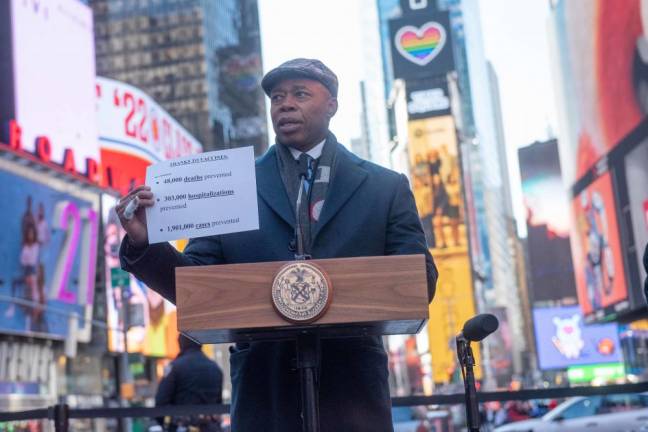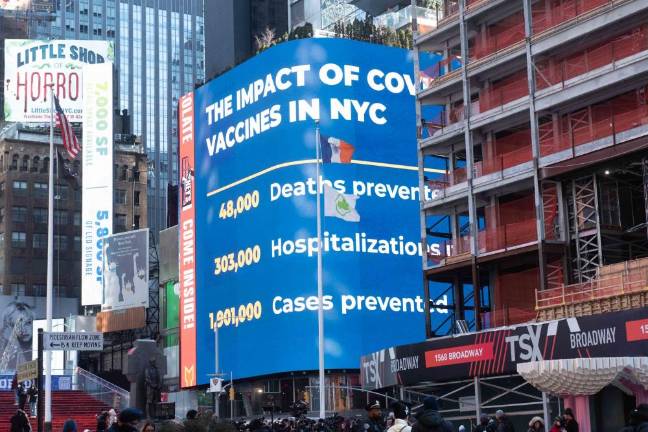‘It’s Time to Open Our City’
COVID Spring: Adams focuses on NYC’s economic recovery as other officials caution about moving too quickly to lift requirements


For a moment in his State of the Union Address, Joe Biden seemed to be speaking directly to Manhattan.
“It’s time for Americans to get back to work and fill our great downtowns again,” he urged. “People working from home can feel safe to begin to return to the office.”
No city has been more disrupted than New York by the flight from the office. No city’s recovery is more intertwined with getting people back to their offices and keeping their kids in school so they don’t have to rush off to care for them.
“We can end the shutdown of schools and businesses,” Biden declared. “We have the tools we need.”
The challenge in this COVID Spring is how to deploy those tools. As the latest wave recedes, the debate has become which mandates we can lift, to make us feel more safe and comfortable in public, and which we had better keep for more or less the same reason.
“Public health policy experts advise this is the time to plan and prepare for the next phase of the pandemic rather than prematurely declare victory,” State Senator Liz Krueger of the East Side cautioned Mayor Eric Adams on Thursday.
Her specific point was that the mayor was moving too quickly to lift certain mask and vaccine requirements.
“The well-being of our health care workers, capacity of our hospital systems, and financial health of our city depend on our ability to prevent or minimize the rise of the next surge,” Krueger wrote in a detailed letter complete with footnotes to scientific papers. “We will not accomplish this if we relax too many layers of our protection too quickly.”
Krueger was far from alone in her qualms. Dr. Jay Varma, former health adviser to Mayor Bill de Blasio and present adviser to Borough President Mark Levine, wrote in the Daily News the same day that Adams was wrong to lift the requirement that patrons show proof of vaccination in restaurants, entertainment venues and fitness clubs.
“Let’s keep our strongest layer of defense as insurance for the uncertain future of COVID-19,” Varma said.
Words and Venue
Adams, buoyant as ever, pressed ahead despite Krueger and Varma’s warnings. He announced Friday that, as of Monday, the city was lifting mask requirements in schools and proof of vaccination rules for restaurant, fitness and theater patrons.
Both in his words and his selected venue for the announcement Adams made clear that the city’s economic recovery was top of mind in his decision.
“It’s time to open our city,” the mayor declared from a podium in Times Square.
Rates of COVID-19 have fallen so low, the mayor proclaimed, that these mandatory masking and vaccination rules are no longer needed.
“We have become so boring as a city,” said Adams. “I want to become a city of excitement. We are looking to reinstate every parade, every festival, every block party. People need to get outdoors and enjoy our city again.”
No one disputed the mayor’s view that COVID-19 is in retreat – again. The challenge is identifying which measures are essential to keep it that way.
“Lifting the vaccination requirement will be counterproductive to the goal of promoting economic recovery while protecting public health,” Krueger wrote. “Lifting the vaccination requirement may actually encourage more unvaccinated people to come to New York City, thereby increasing community transmission and prolonging the pandemic.”
Visitors and Kids
Since Adult New Yorkers are widely vaccinated (only 3.4 percent are entirely unvaccinated), the city’s biggest vulnerabilities are visitors and kids (35 percent of children 5 to 17 are still unvaccinated and kids five and under are not yet eligible).
This was noted by the city’s two other citywide elected officials, Brad Lander, the comptroller and Jumaane Williams, the public advocate, who suggested to the mayor that as he was reconsidering mandates he should impose a new one to require every student be vaccinated against COVID-19 by September, as kids are for other potential infections.
Adams said he was thinking about it.
His choice of Times Square to announce the lifting of mandates dramatized his focus on bringing the city back to life. The two biggest challenges in that effort are bringing workers back to their offices and travelers back to the city. Offices in midtown and downtown are still barely a third occupied and travel and tourism remains far below pre-pandemic levels.
The mayor’s decision to lift some mandates is probably more relevant to reviving the travel portion of the city’s economy than to bringing office districts back to life, said Kathryn Wylde, president of the Partnership for New York.
As he lifted vaccine requirements for patrons of indoor venues, Mayor left in place the requirement that both public and private employees be vaccinated, which created the widely observed oddity that Kyrie Irving, star guard for the Brooklyn Nets and vaccine refuser, could now attend Nets home games but not take the court.
“A Robust Return”
But for all the times the mayor has been asked about the Irving situation (he wants a championship as much as the next guy, but making exceptions would send the wrong message), Wylde notes that most private employers have set their own vaccine requirement and that the city has not enforced its private sector vaccine rules.
“It certainly has no impact on return to the office,” Wylde said of the mayor’s mandate changes. “Because virtually 100 percent of office workers are vaccinated and boosted and most offices are asking the people who visit their office to be vaccinated as well.”
The city’s business community is hoping to see office use back to about fifty percent by May or June and then “a robust return” to something like a new normal after Labor Day, Wylde reported. “Assuming we get through the summer.”
“From a practical standpoint the city’s vaccination mandate is irrelevant,” Wylde said. “When tourists start to come back and go into restaurant that’s a different kettle of fish.”
But by all accounts, visitors are returning more slowly, particularly the most lucrative portion of the travel market, business and international travelers. The mayor’s effort to revive New York as a fun and exciting place may help a bit, although most of the forces retarding global travel are likely beyond his reach.
Making it easier to go out to eat or take in an event might make the city feel more inviting to travelers. That would be good for the local economy, Wylde noted, “but not if they bring COVID with them.”
No one disputed the mayor’s view that COVID-19 is in retreat – again. The challenge is identifying which measures are essential to keep it that way.